CHRYSLER ASPEN 2008 2.G Owners Manual
Manufacturer: CHRYSLER, Model Year: 2008, Model line: ASPEN, Model: CHRYSLER ASPEN 2008 2.GPages: 479, PDF Size: 4.3 MB
Page 261 of 479
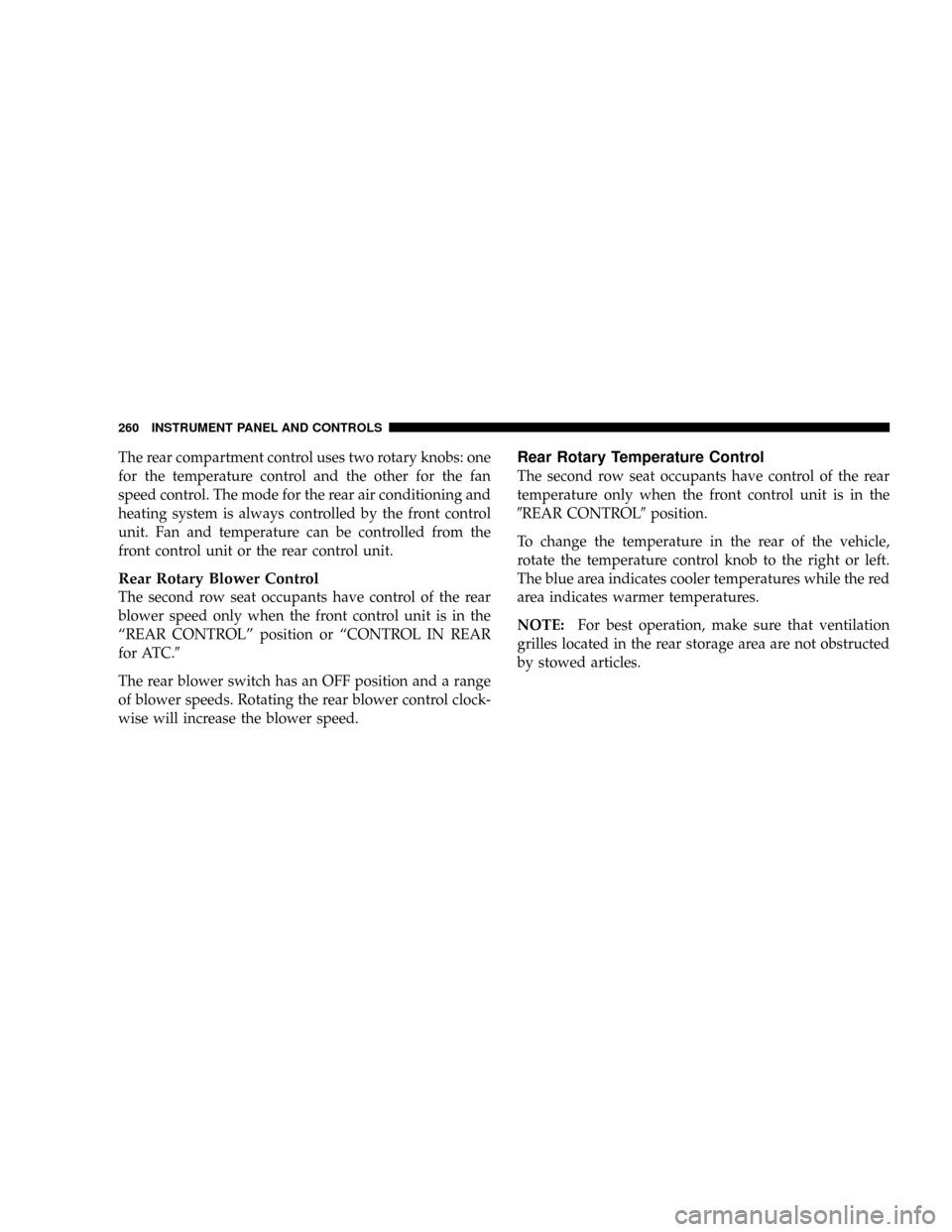
The rear compartment control uses two rotary knobs: one
for the temperature control and the other for the fan
speed control. The mode for the rear air conditioning and
heating system is always controlled by the front control
unit. Fan and temperature can be controlled from the
front control unit or the rear control unit.
Rear Rotary Blower Control
The second row seat occupants have control of the rear
blower speed only when the front control unit is in the
ªREAR CONTROLº position or ªCONTROL IN REAR
for ATC.9
The rear blower switch has an OFF position and a range
of blower speeds. Rotating the rear blower control clock-
wise will increase the blower speed.
Rear Rotary Temperature Control
The second row seat occupants have control of the rear
temperature only when the front control unit is in the
9REAR CONTROL9position.
To change the temperature in the rear of the vehicle,
rotate the temperature control knob to the right or left.
The blue area indicates cooler temperatures while the red
area indicates warmer temperatures.
NOTE:For best operation, make sure that ventilation
grilles located in the rear storage area are not obstructed
by stowed articles.
260 INSTRUMENT PANEL AND CONTROLS
Page 262 of 479
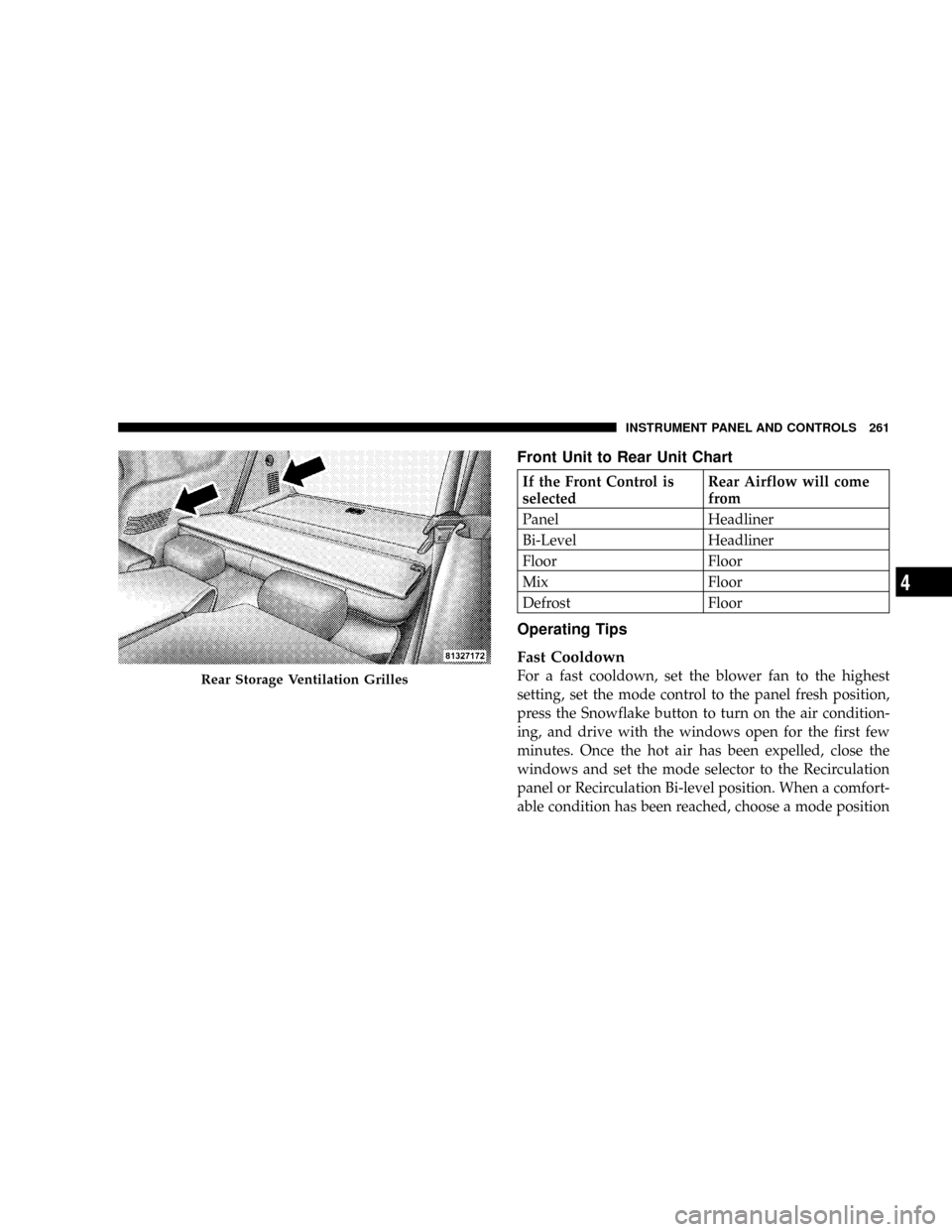
Front Unit to Rear Unit Chart
If the Front Control is
selectedRear Airflow will come
from
Panel Headliner
Bi-Level Headliner
Floor Floor
Mix Floor
Defrost Floor
Operating Tips
Fast Cooldown
For a fast cooldown, set the blower fan to the highest
setting, set the mode control to the panel fresh position,
press the Snowflake button to turn on the air condition-
ing, and drive with the windows open for the first few
minutes. Once the hot air has been expelled, close the
windows and set the mode selector to the Recirculation
panel or Recirculation Bi-level position. When a comfort-
able condition has been reached, choose a mode positionRear Storage Ventilation Grilles
INSTRUMENT PANEL AND CONTROLS 261
4
Page 263 of 479
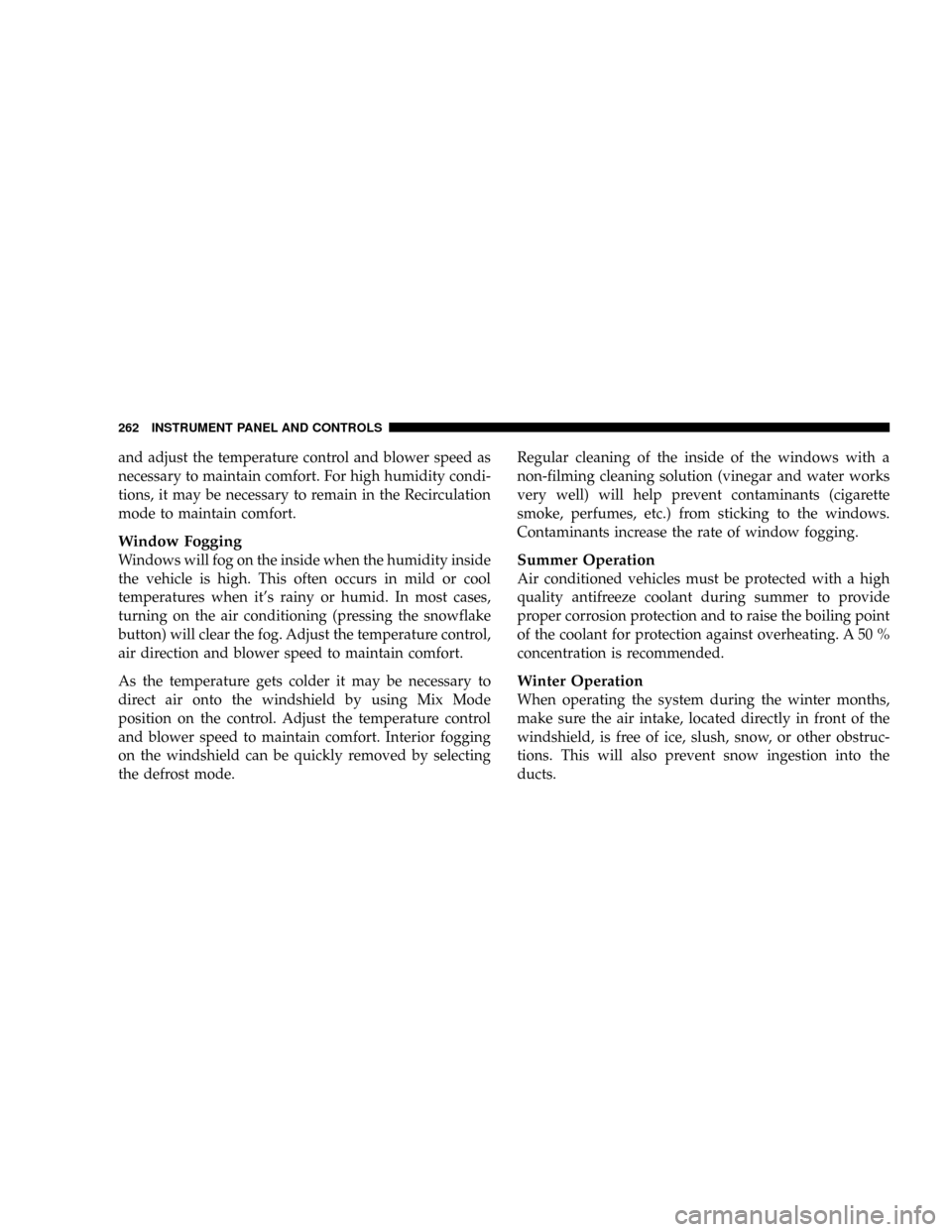
and adjust the temperature control and blower speed as
necessary to maintain comfort. For high humidity condi-
tions, it may be necessary to remain in the Recirculation
mode to maintain comfort.
Window Fogging
Windows will fog on the inside when the humidity inside
the vehicle is high. This often occurs in mild or cool
temperatures when it's rainy or humid. In most cases,
turning on the air conditioning (pressing the snowflake
button) will clear the fog. Adjust the temperature control,
air direction and blower speed to maintain comfort.
As the temperature gets colder it may be necessary to
direct air onto the windshield by using Mix Mode
position on the control. Adjust the temperature control
and blower speed to maintain comfort. Interior fogging
on the windshield can be quickly removed by selecting
the defrost mode.Regular cleaning of the inside of the windows with a
non-filming cleaning solution (vinegar and water works
very well) will help prevent contaminants (cigarette
smoke, perfumes, etc.) from sticking to the windows.
Contaminants increase the rate of window fogging.Summer Operation
Air conditioned vehicles must be protected with a high
quality antifreeze coolant during summer to provide
proper corrosion protection and to raise the boiling point
of the coolant for protection against overheating. A 50 %
concentration is recommended.
Winter Operation
When operating the system during the winter months,
make sure the air intake, located directly in front of the
windshield, is free of ice, slush, snow, or other obstruc-
tions. This will also prevent snow ingestion into the
ducts.
262 INSTRUMENT PANEL AND CONTROLS
Page 264 of 479
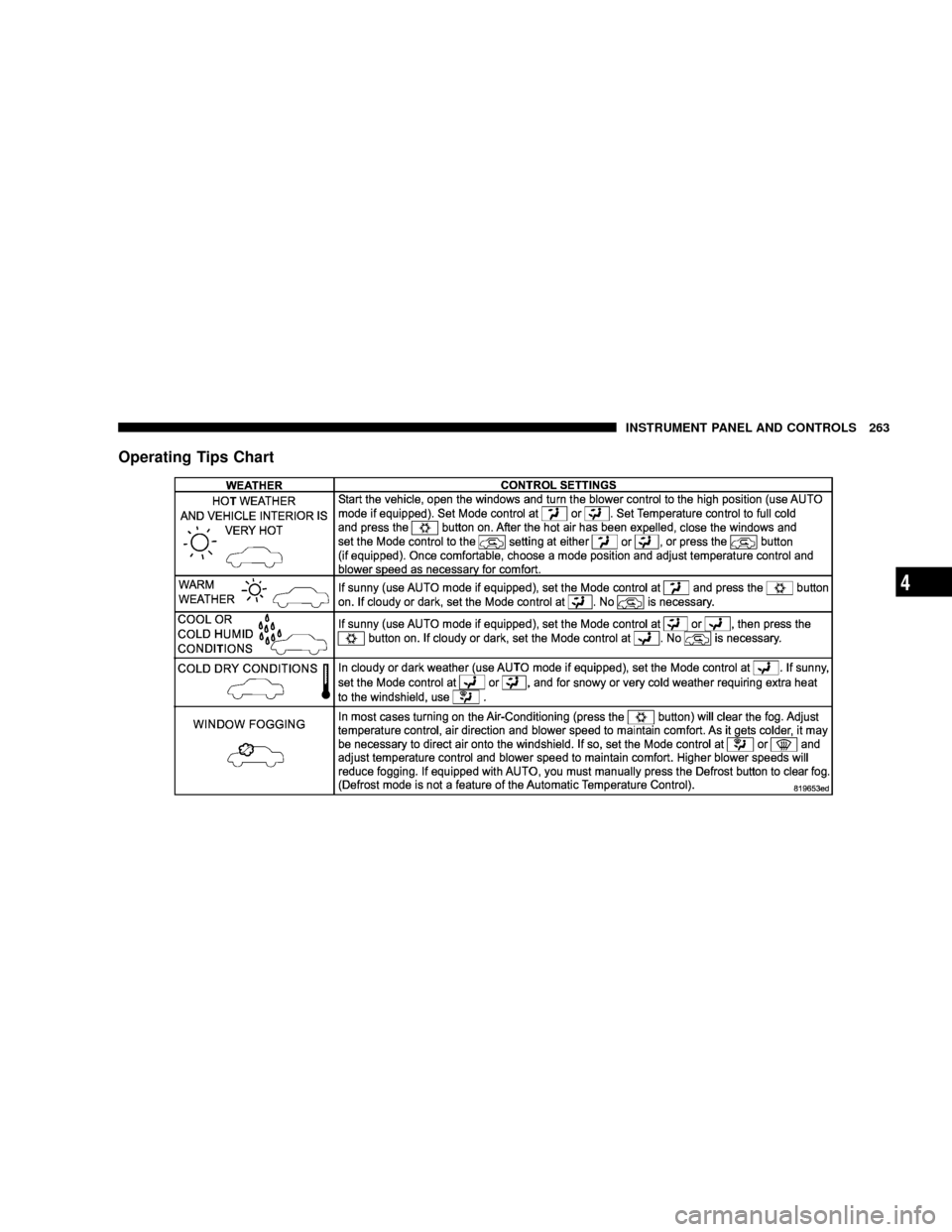
Operating Tips Chart
INSTRUMENT PANEL AND CONTROLS 263
4
Page 265 of 479
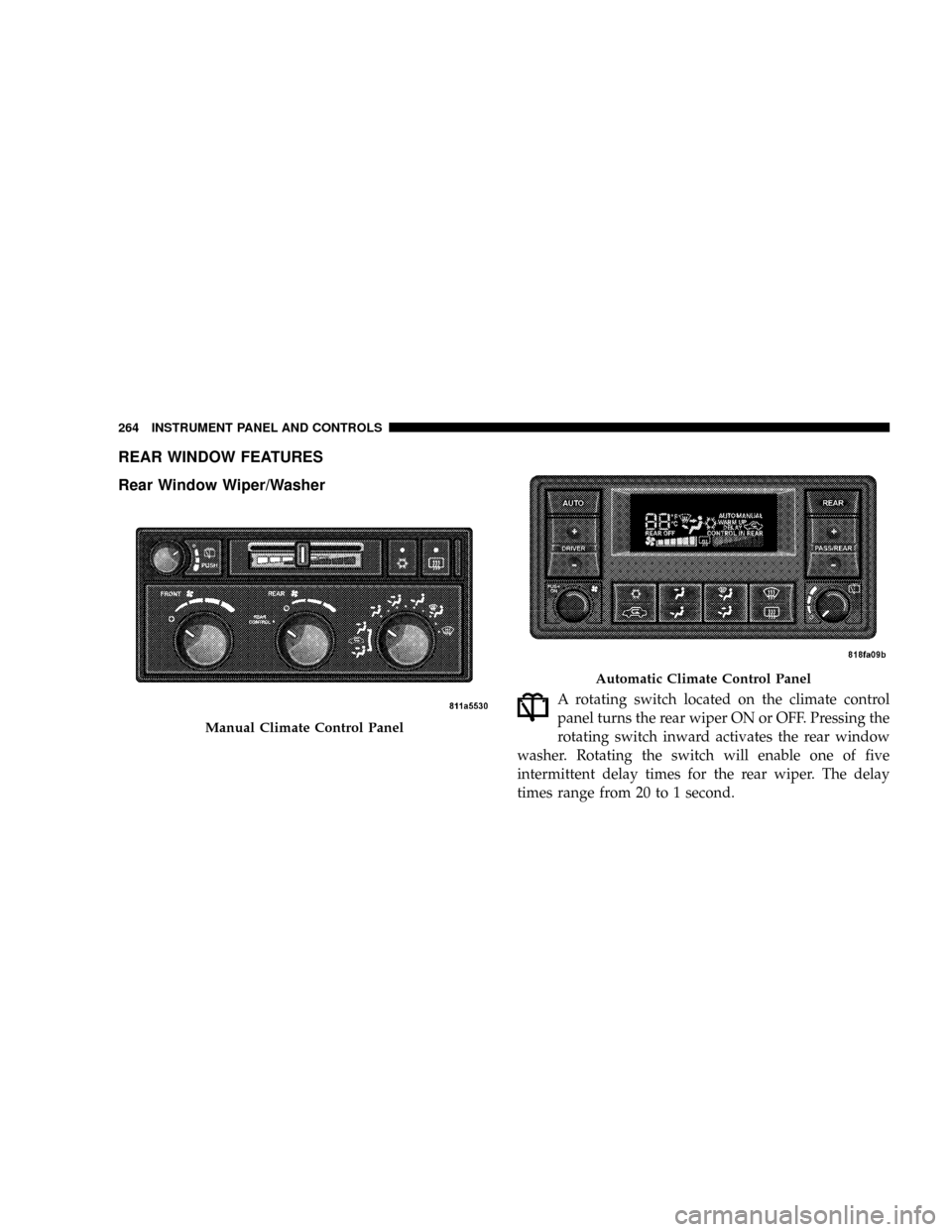
REAR WINDOW FEATURES
Rear Window Wiper/Washer
A rotating switch located on the climate control
panel turns the rear wiper ON or OFF. Pressing the
rotating switch inward activates the rear window
washer. Rotating the switch will enable one of five
intermittent delay times for the rear wiper. The delay
times range from 20 to 1 second.
Manual Climate Control Panel
Automatic Climate Control Panel
264 INSTRUMENT PANEL AND CONTROLS
Page 266 of 479
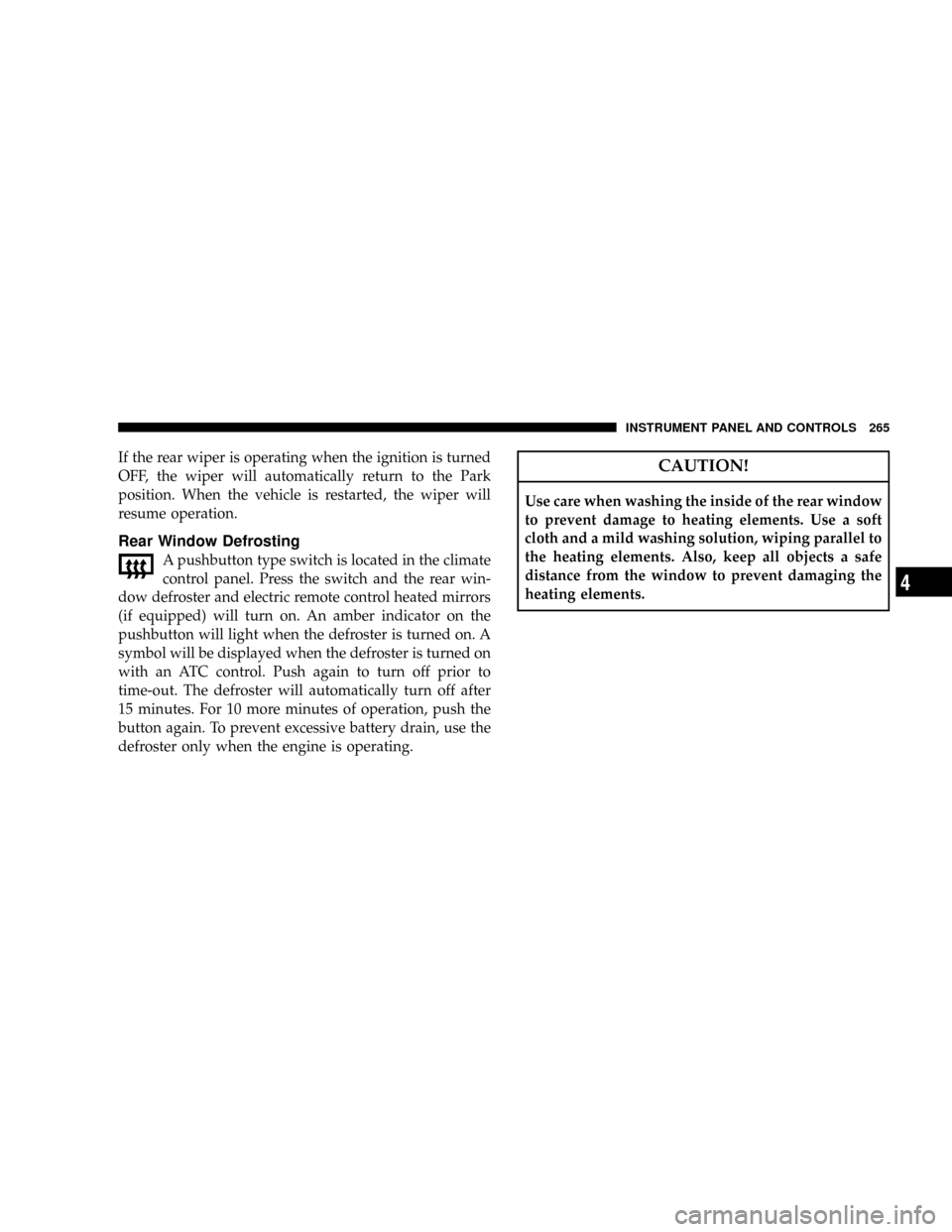
If the rear wiper is operating when the ignition is turned
OFF, the wiper will automatically return to the Park
position. When the vehicle is restarted, the wiper will
resume operation.
Rear Window Defrosting
A pushbutton type switch is located in the climate
control panel. Press the switch and the rear win-
dow defroster and electric remote control heated mirrors
(if equipped) will turn on. An amber indicator on the
pushbutton will light when the defroster is turned on. A
symbol will be displayed when the defroster is turned on
with an ATC control. Push again to turn off prior to
time-out. The defroster will automatically turn off after
15 minutes. For 10 more minutes of operation, push the
button again. To prevent excessive battery drain, use the
defroster only when the engine is operating.
CAUTION!
Use care when washing the inside of the rear window
to prevent damage to heating elements. Use a soft
cloth and a mild washing solution, wiping parallel to
the heating elements. Also, keep all objects a safe
distance from the window to prevent damaging the
heating elements.
INSTRUMENT PANEL AND CONTROLS 265
4
Page 267 of 479

Page 268 of 479

STARTING AND OPERATING
CONTENTS
mStarting Procedures.....................271
NAutomatic Transmission................271
NNormal Starting......................271
mEngine Block Heater ± If Equipped..........274
mAutomatic Transmission..................274
NBrake/Transmission Interlock System.......274
NGear Ranges.........................275
NOverdrive Operation...................277
NWhen To Use Tow/Haul Mode...........278NTorque Converter Clutch................279
mFour-Wheel Drive Operation...............280
NNV 140 Transfer Case Operating
Information/Precautions ± If Equipped......280
NNV 244 Generation II Transfer Case Operating
Information / Precautions...............280
NShifting Procedure - NV 244 Generation II
Transfer Case........................284
mDriving On Slippery Surfaces..............286
mDriving Through Water..................286
5
Page 269 of 479
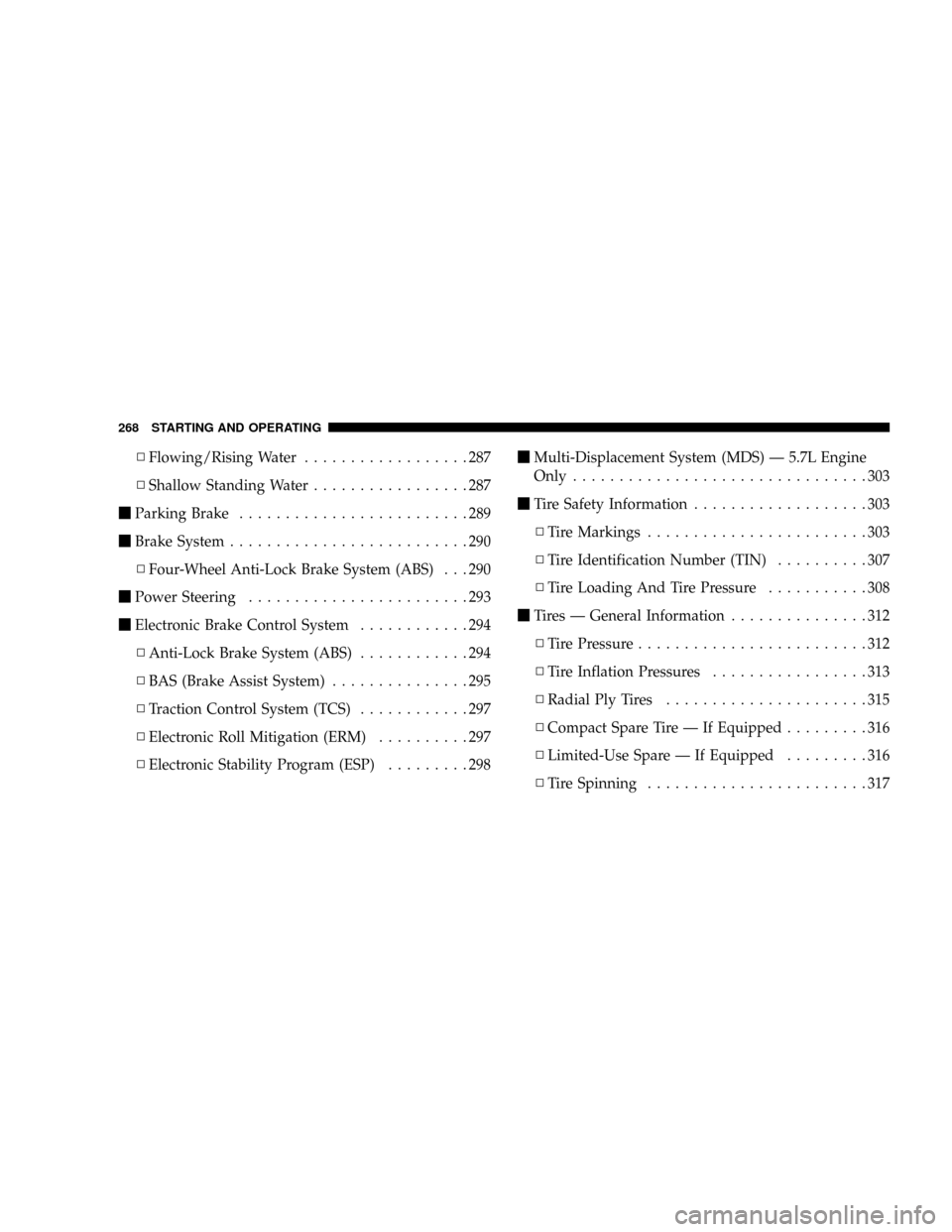
NFlowing/Rising Water..................287
NShallow Standing Water.................287
mParking Brake.........................289
mBrake System..........................290
NFour-Wheel Anti-Lock Brake System (ABS) . . . 290
mPower Steering........................293
mElectronic Brake Control System............294
NAnti-Lock Brake System (ABS)............294
NBAS (Brake Assist System)...............295
NTraction Control System (TCS)............297
NElectronic Roll Mitigation (ERM)..........297
NElectronic Stability Program (ESP).........298mMulti-Displacement System (MDS) Ð 5.7L Engine
Only................................303
mTire Safety Information...................303
NTire Markings........................303
NTire Identification Number (TIN)..........307
NTire Loading And Tire Pressure...........308
mTires Ð General Information...............312
NTire Pressure.........................312
NTire Inflation Pressures.................313
NRadial Ply Tires......................315
NCompact Spare Tire Ð If Equipped.........316
NLimited-Use Spare Ð If Equipped.........316
NTire Spinning........................317
268 STARTING AND OPERATING
Page 270 of 479
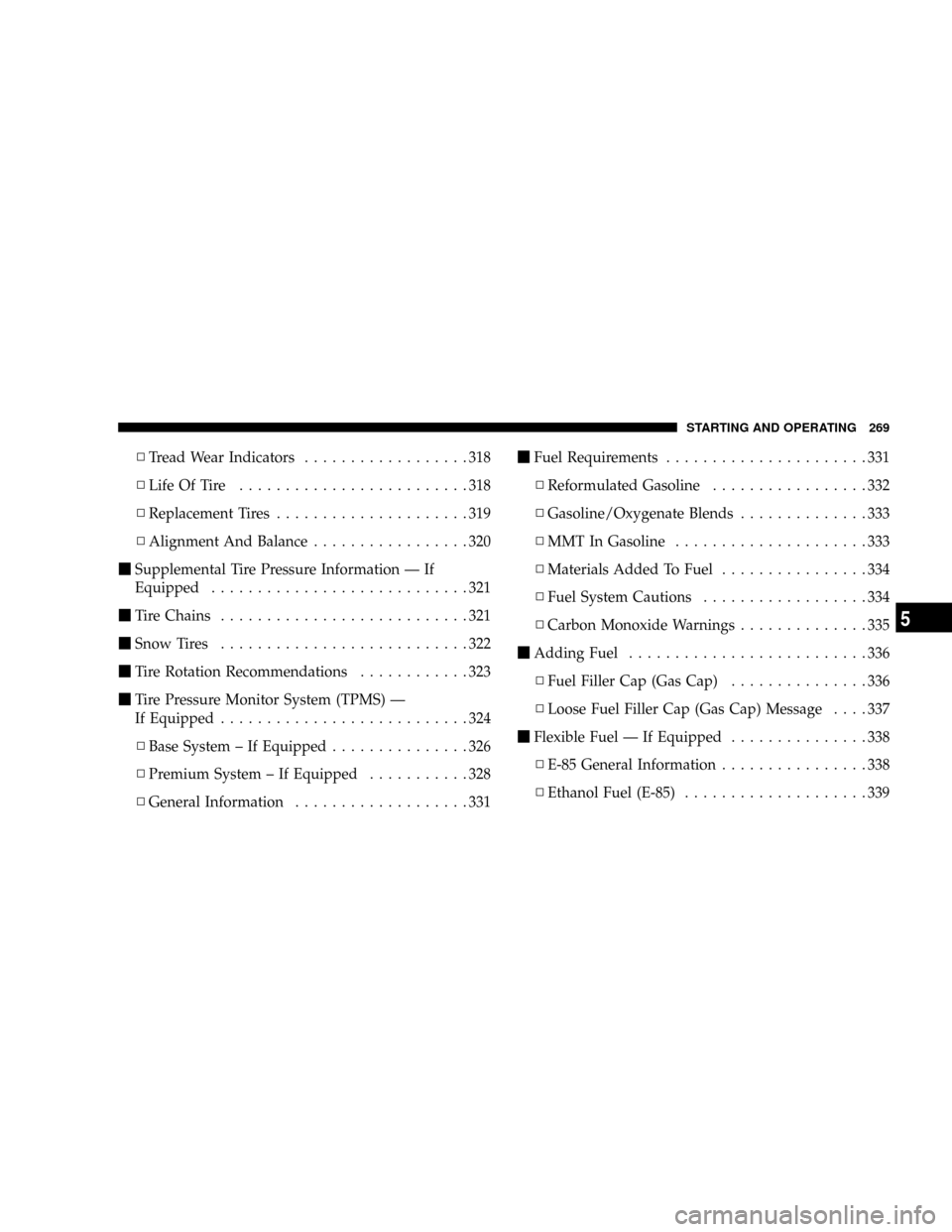
NTread Wear Indicators..................318
NLife Of Tire.........................318
NReplacement Tires.....................319
NAlignment And Balance.................320
mSupplemental Tire Pressure Information Ð If
Equipped............................321
mTire Chains...........................321
mSnow Tires...........................322
mTire Rotation Recommendations............323
mTire Pressure Monitor System (TPMS) Ð
If Equipped...........................324
NBase System ± If Equipped...............326
NPremium System ± If Equipped...........328
NGeneral Information...................331mFuel Requirements......................331
NReformulated Gasoline.................332
NGasoline/Oxygenate Blends..............333
NMMT In Gasoline.....................333
NMaterials Added To Fuel................334
NFuel System Cautions..................334
NCarbon Monoxide Warnings..............335
mAdding Fuel..........................336
NFuel Filler Cap (Gas Cap)...............336
NLoose Fuel Filler Cap (Gas Cap) Message....337
mFlexible Fuel Ð If Equipped...............338
NE-85 General Information................338
NEthanol Fuel (E-85)....................339
STARTING AND OPERATING 269
5